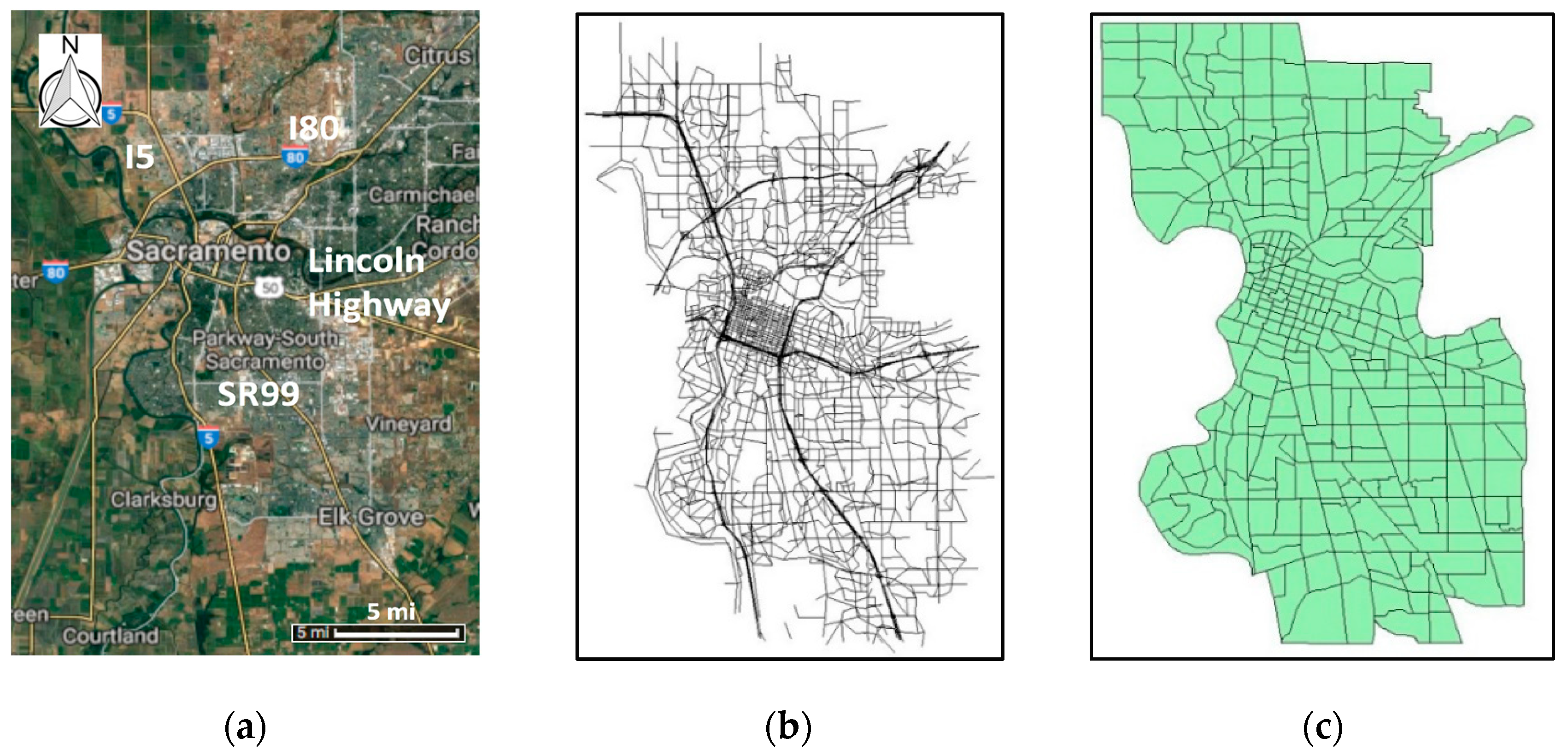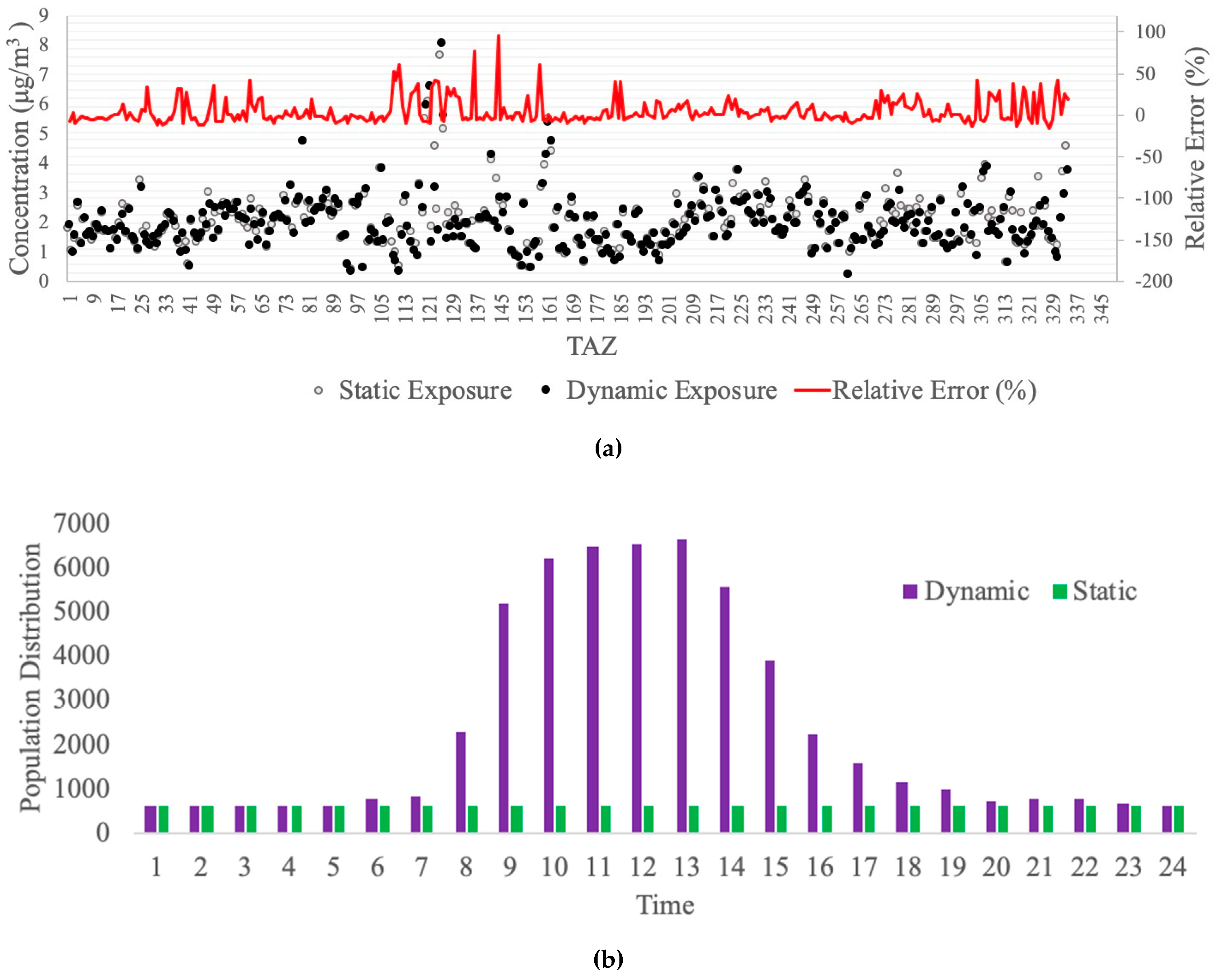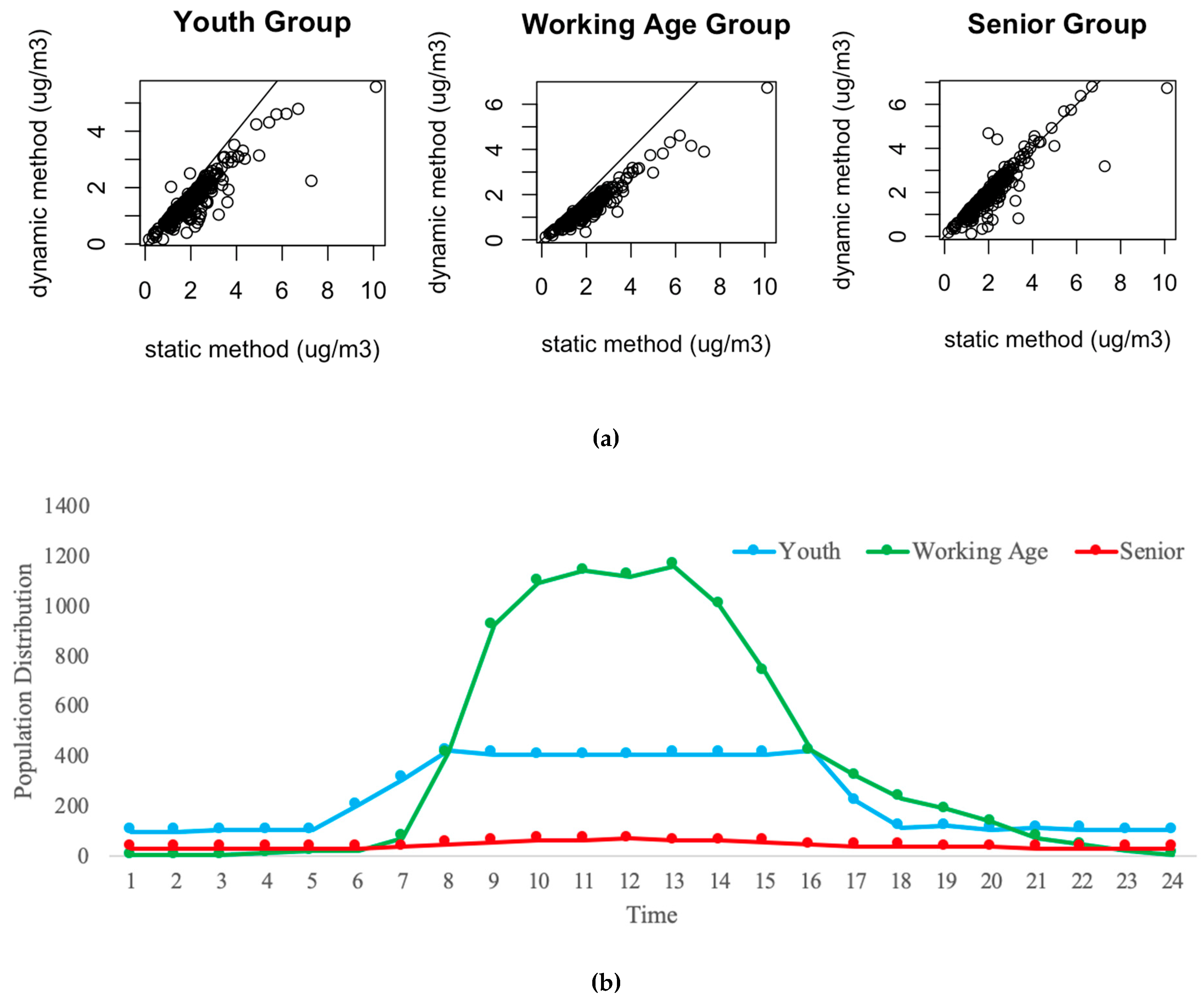The Impact of Activity-Based Mobility Pattern on Assessing Fine-Grained Traffic-Induced Air Pollution Exposure
Abstract
:1. Introduction
2. Methods and Data
2.1. Air Quality Modeling Framework
2.2. Human Exposure Assessment
2.3. Case Study Setup
2.3.1. Estimates of Traffic-Induced Emissions
2.3.2. Estimates of Air Pollution Concentrations
2.3.3. Extraction of Activity Pattern
3. Results and Discussion
3.1. Vehicle Emission Rates
3.2. Air Pollution Concentrations
3.3. Population Distribution
3.4. Comparison between Dynamic and Static Population Exposure
4. Conclusions and Future Directions
Author Contributions
Funding
Acknowledgments
Conflicts of Interest
References
- CARB. Draft Community Air Protection Blueprint; CARB: Sacramento, CA, USA, 2018. [Google Scholar]
- United States Environmental Protection Agency. Transportation Conformity Guidance for Quantitative Hot-Spot Analyses in PM2.5 and PM10 Nonattainment and Maintenance Areas; United States Environmental Protection Agency: Ann Arbor, MI, USA, 2015.
- Pope III, C.A.; Burnett, R.T.; Thun, M.J.; Calle, E.E.; Krewski, D.; Ito, K.; Thurston, G.D. Lung cancer, cardiopulmonary mortality, and long-term exposure to fine particulate air pollution. JAMA 2002, 287, 1132–1141. [Google Scholar] [CrossRef] [PubMed]
- Dockery, D.W.; Pope, C.A.; Xu, X.; Spengler, J.D.; Ware, J.H.; Fay, M.E.; Ferris, B.G.; Speizer, F.E. An association between air pollution and mortality in six US cities. N. Engl. J. Med. 1993, 329, 1753–1759. [Google Scholar] [CrossRef] [PubMed]
- Hoek, G.; Krishnan, R.M.; Beelen, R.; Peters, A.; Ostro, B.; Brunekreef, B.; Kaufman, J.D. Long-term air pollution exposure and cardio-respiratory mortality: A review. Environ. Health 2013, 12, 43. [Google Scholar] [CrossRef] [PubMed]
- Hatzopoulou, M.; Miller, E.J. Linking an activity-based travel demand model with traffic emission and dispersion models: Transport’s contribution to air pollution in Toronto. Transp. Res. Part Transp. Environ. 2010, 15, 315–325. [Google Scholar] [CrossRef]
- Rowangould, G.M. A new approach for evaluating regional exposure to particulate matter emissions from motor vehicles. Transp. Res. Part Transp. Environ. 2015, 34, 307–317. [Google Scholar] [CrossRef]
- Tayarani, M.; Poorfakhraei, A.; Nadafianshahamabadi, R.; Rowangould, G.M. Evaluating unintended outcomes of regional smart-growth strategies: Environmental justice and public health concerns. Transp. Res. Part Transp. Environ. 2016, 49, 280–290. [Google Scholar] [CrossRef]
- Rowangould, D.; Rowangould, G.; Niemeier, D. Evaluation of the Health Impacts of Rolling Back a Port Clean Trucks Program. Transp. Res. Rec. 2018, 2672, 53–64. [Google Scholar] [CrossRef]
- Poorfakhraei, A.; Tayarani, M.; Rowangould, G. Evaluating health outcomes from vehicle emissions exposure in the long range regional transportation planning process. J. Transp. Health 2017, 6, 501–515. [Google Scholar] [CrossRef]
- Hart, J.E.; Garshick, E.; Dockery, D.W.; Smith, T.J.; Ryan, L.; Laden, F. Long-Term Ambient Multipollutant Exposures and Mortality. Am. J. Respir. Crit. Care Med. 2011, 183, 73–78. [Google Scholar] [CrossRef] [PubMed] [Green Version]
- Miller, K.A.; Siscovick, D.S.; Sheppard, L.; Shepherd, K.; Sullivan, J.H.; Anderson, G.L.; Kaufman, J.D. Long-Term Exposure to Air Pollution and Incidence of Cardiovascular Events in Women. N. Engl. J. Med. 2007, 356, 447–458. [Google Scholar] [CrossRef] [PubMed]
- Beckx, C.; Int Panis, L.; Arentze, T.; Janssens, D.; Torfs, R.; Broekx, S.; Wets, G. A dynamic activity-based population modelling approach to evaluate exposure to air pollution: Methods and application to a Dutch urban area. Environ. Impact Assess. Rev. 2009, 29, 179–185. [Google Scholar] [CrossRef]
- Dhondt, S.; Beckx, C.; Degraeuwe, B.; Lefebvre, W.; Kochan, B.; Bellemans, T.; Int Panis, L.; Macharis, C.; Putman, K. Health impact assessment of air pollution using a dynamic exposure profile: Implications for exposure and health impact estimates. Environ. Impact Assess. Rev. 2012, 36, 42–51. [Google Scholar] [CrossRef]
- Nyhan, M.; Grauwin, S.; Britter, R.; Misstear, B.; McNabola, A.; Laden, F.; Barrett, S.R.H.; Ratti, C. “Exposure Track”—The Impact of Mobile-Device-Based Mobility Patterns on Quantifying Population Exposure to Air Pollution. Environ. Sci. Technol. 2016, 50, 9671–9681. [Google Scholar] [CrossRef] [PubMed]
- Bradley, M.; Bowman, J.L.; Griesenbeck, B. SACSIM: An applied activity-based model system with fine-level spatial and temporal resolution. J. Choice Model. 2010, 3, 5–31. [Google Scholar] [CrossRef] [Green Version]
- SACOG. Metropolitan Transportation Plan/Sustainable Communities Strategy 2016. Available online: https://www.sacog.org/2016-mtpscs (accessed on 23 July 2017).
- Karner, A.; Eisinger, D.; Niemeier, D. Near-Roadway Air Quality: Synthesizing the Findings from Real-World Data. Environ. Sci. Technol. 2010, 44, 5334–5344. [Google Scholar] [CrossRef] [PubMed]
- R Core Team. A Language and Environment for Statistical Computing; R Foundation for Statistical Computing: Vienna, Austria, 2013. [Google Scholar]
- Vallamsundar, S.; Lin, J.; Konduri, K.; Zhou, X.; Pendyala, R.M. A comprehensive modeling framework for transportation-induced population exposure assessment. Transp. Res. Part Transp. Environ. 2016, 46, 94–113. [Google Scholar] [CrossRef]
- Kampa, M.; Castanas, E. Human health effects of air pollution. Environ. Pollut. 2008, 151, 362–367. [Google Scholar] [CrossRef] [PubMed]
- Steinle, S.; Reis, S.; Sabel, C.E. Quantifying human exposure to air pollution—Moving from static monitoring to spatio-temporally resolved personal exposure assessment. Sci. Total Environ. 2013, 443, 184–193. [Google Scholar] [CrossRef] [PubMed]
- Quigley, R.; den Broeder, L.; Furu, P.; Bond, A.; Cave, B.; Bos, R. Health Impact Assessment International Best Practice Principles. Available online: https://ueaeprints.uea.ac.uk/20178/ (accessed on 26 August 2019).







| Transportation Inputs | Scenario |
|---|---|
| New or expanded roads (lane miles, percent increase from 2008) | 31% |
| Transit service (vehicle service hours, percent increases from 2008) | 88% |
| Funding for maintaining and operating the transit system ($ in billions) | $7.9 |
| Funding for new or expanded bus and light rail lines ($ in billions) | $3.4 |
| Funding for bike and pedestrian routes and trail improvements ($ in billions) | $2.8 |
| Additional miles of bicycle paths, lanes and routes | 1100 |
| Sample Number | Person Number | Trip Number | Origin TAZ | Destination TAZ | Departure Time | Arrival Time |
|---|---|---|---|---|---|---|
| 1 | 1 | 1 | 1240 | 1347 | 16:05 | 16:12 |
| 1 | 1 | 2 | 1347 | 1246 | 18:46 | 18:50 |
| 1 | 1 | 3 | 1246 | 1240 | 18:57 | 19:01 |
| Population Counts (Male; 15–29 Years Old) | Hour 1 | Hour 2 | Hour 3 | … |
|---|---|---|---|---|
| TAZ 1 | 509 | 509 | 508 | … |
| TAZ 2 | 687 | 687 | 687 | … |
| TAZ 3 | 982 | 982 | 980 | … |
| … | … | … | … | … |
© 2019 by the authors. Licensee MDPI, Basel, Switzerland. This article is an open access article distributed under the terms and conditions of the Creative Commons Attribution (CC BY) license (http://creativecommons.org/licenses/by/4.0/).
Share and Cite
Wu, Y.; Song, G. The Impact of Activity-Based Mobility Pattern on Assessing Fine-Grained Traffic-Induced Air Pollution Exposure. Int. J. Environ. Res. Public Health 2019, 16, 3291. https://doi.org/10.3390/ijerph16183291
Wu Y, Song G. The Impact of Activity-Based Mobility Pattern on Assessing Fine-Grained Traffic-Induced Air Pollution Exposure. International Journal of Environmental Research and Public Health. 2019; 16(18):3291. https://doi.org/10.3390/ijerph16183291
Chicago/Turabian StyleWu, Yizheng, and Guohua Song. 2019. "The Impact of Activity-Based Mobility Pattern on Assessing Fine-Grained Traffic-Induced Air Pollution Exposure" International Journal of Environmental Research and Public Health 16, no. 18: 3291. https://doi.org/10.3390/ijerph16183291
APA StyleWu, Y., & Song, G. (2019). The Impact of Activity-Based Mobility Pattern on Assessing Fine-Grained Traffic-Induced Air Pollution Exposure. International Journal of Environmental Research and Public Health, 16(18), 3291. https://doi.org/10.3390/ijerph16183291




